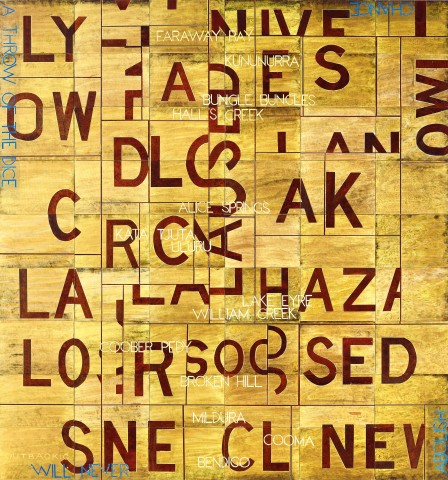OUTBACK: C, 2005
IMANTS TILLERS
synthetic polymer paint on 54 canvas boards
228.0 x 213.0 cm overall
each panel numbered sequentially with stencil verso: 76222 – 76275
Sherman Galleries, Sydney
Private collection, Sydney, acquired from the above in 2005
Imants Tillers: Land Beyond Goodbye, Sherman Galleries, Sydney, 20 October – 12 November 2005, cat. 9 (illus. in exhibition catalogue)
Spring 2019, Annette Larkin Fine Art, Sydney, 4 September – 12 October 2019
Imants Tillers’ Outback paintings comprise a specific chapter in the vast anthology of his canvas-board works, numbered consecutively since 1981, and titled The Book of Power. This series, embarked upon in June 2003, refers to what the artists calls ’the spiritual heart of Australia’1 and forms a kind of historiography of the Western artistic interpretation of the landscape, reprising well-known works from Glover to Gascoigne. Key to Tillers’ work is the idea that the landscape is a constructed space and one haunted by the spirit of the place, the genius loci, for the first Australians and their colonisers. A postmodern artist par excellence, Tillers’ longstanding artistic practice has been founded on its devices: appropriation, grid-based reproduction and application of text, and stenciled overlay on the painted surface. The canvas boards have become a system through which Tillers can compartmentalise and study the Australian landscape in art, creating a continuous dialogue between the artistic object, the subject and the audience. In the vast scale of Outback: C, Tillers has appropriated Rosalie Gascoigne’s iconic retro-reflective street sign assemblage, painstakingly reconstructing the segmented panels of her work, Conundrum, 1989-90, held in the collection of the University of Melbourne.
Outback: C addresses succinctly Tillers’ key themes of diaspora and post-colonial identity. In blue writing, on the uppermost layer of superimposed text, Tillers has copied out the words ‘A throw of the dice will never change history’. Read in conjunction with the adjacent cascading list of place names from north to south of the continent – Kununurra to Bendigo – this aphorism alludes to the underlying truths of belonging and sovereignty over the land. The artist describes his use of place names in these works as a kind of ’ready-made poetry’. In addressing the historical issue of misappropriated land, Tillers’ reprisal of road signs through the prism of Gascoigne’s works, is fitting. Both artists arrange sliced and spliced lettering into grids on to a backing support. Rosalie Gascoigne was herself a post-modernist, working with industrial readymades from the 1980s, using plywood road signs with retroreflective film in grid-like assemblages. The words in Gascoigne’s works sometimes remained intact, arranged into cryptic haikus of syllables – here the composite nature of language mirrors the cumulative experience of the Australian landscape, the checkered history of political oppression and subjugation. Tillers, as a first generation Australian, feels endowed with a special insight into post-colonial cross-cultural identity, which he places foremost in his practice.
An influential practitioner and advocate of conceptual art and post-modern discourse in Australia, Tillers’ interrogates the ways in which we interact with the landscape, and addresses the unique perspectives which have coloured each previous artistic attempt to capture its essence. With an overarching systematic approach, Tiller’s oeuvre is remarkably cohesive and each separate work is in constant dialogue with its siblings, constructed of over one hundred thousand individual canvas boards. Two-time winner of the Wynne Prize for landscape painting, Imants Tillers’ artistic discourse is commanding, an impressive string of accolades further confirming the importance of his contribution to the landscape of contemporary art in Australia.
1. Artist’s statement, Land Beyond Goodbye, exhibition catalogue, Sherman Galleries, 30 August 2005
LUCIE REEVES-SMITH
